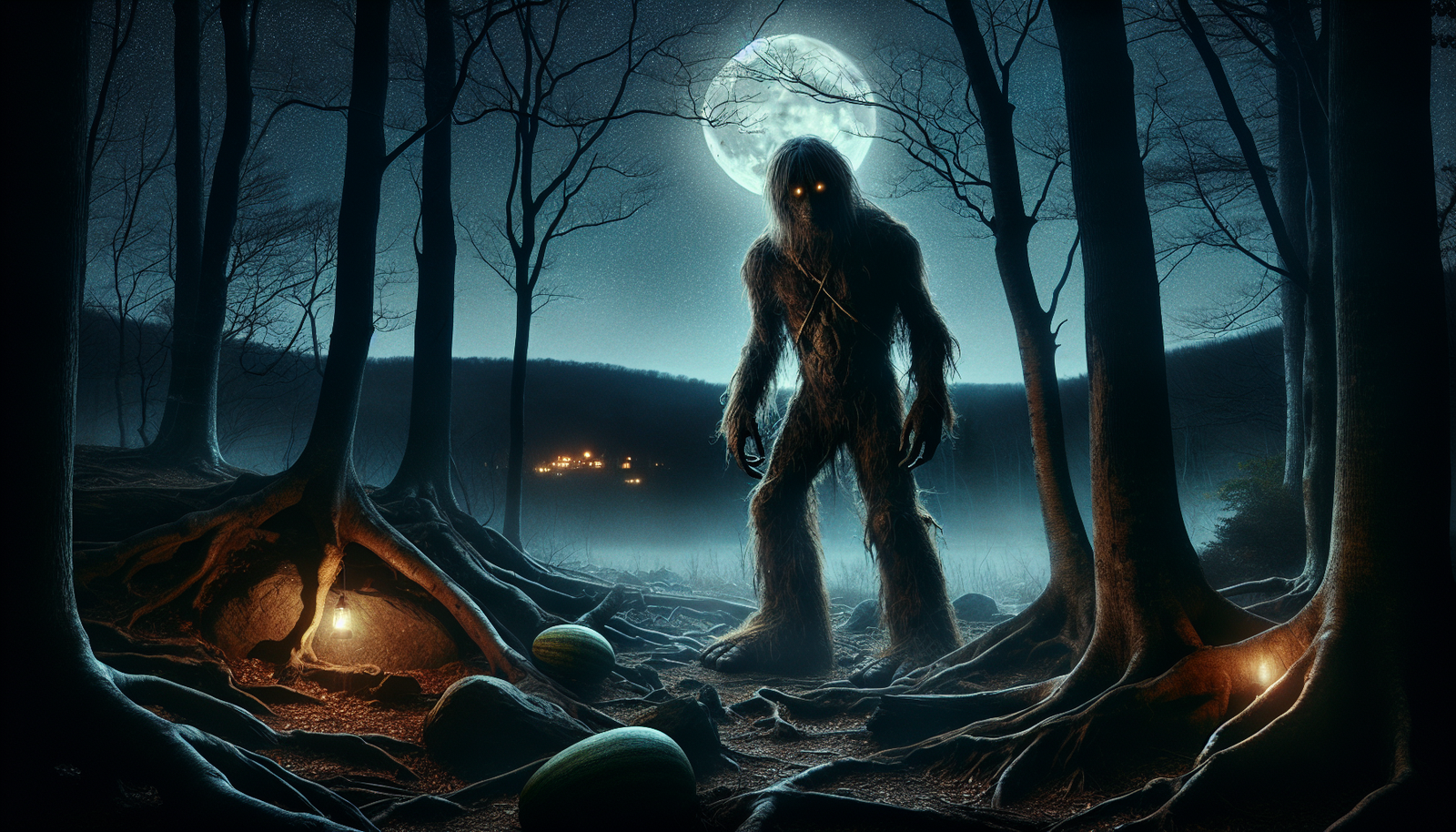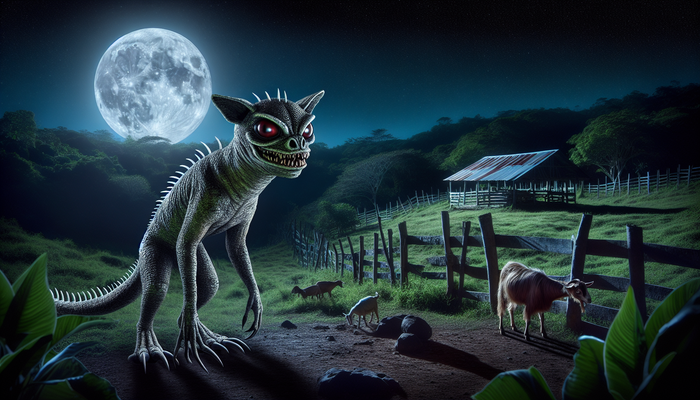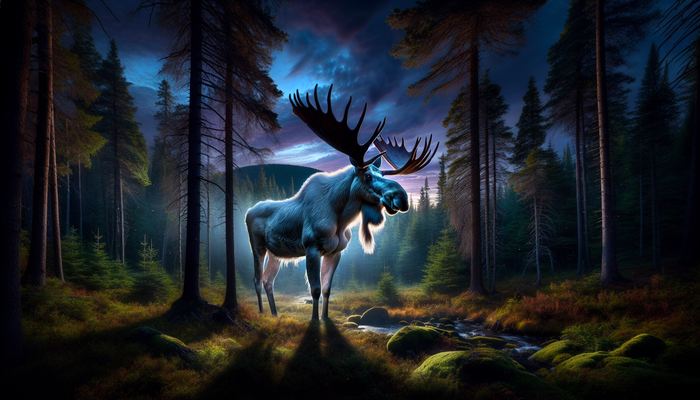Connecticut's Captivating Cryptids

By Jack Sullivan, Bigfoot Researcher
In the misty forests and shadowed corners of Connecticut, whispers of strange creatures have echoed for generations. As a lifelong Bigfoot researcher, I've always been drawn to tales of cryptids - those legendary beasts that dance on the line between myth and reality. And let me tell you, the Nutmeg State has no shortage of these captivating critters. From the eerie Melon Heads to the ghostly Black Dog, Connecticut's cryptid lore is as rich and varied as the landscapes where these creatures allegedly roam. Join me as we stalk the shadows and unravel the mysterious tales behind the state's most famous fantastical fauna. By the end of our journey, you'll see that there's more to these legends than mere campfire stories - they're a reflection of our deepest fears, wildest imaginations, and unshakable fascination with the unknown.
The Melon Heads: Fairfield County's Eerie Humanoids
Picture this: you're hiking through the dense woods of southwestern Connecticut when you spot a pale, spindly figure darting between the trees. As it turns to face you, your blood runs cold. Its head is unnaturally large and bulbous, like a sickly, oversized melon. Congratulations, you've just had a run-in with the infamous Melon Heads.
These strange humanoids have been a staple of Fairfield and New Haven County folklore for decades. Described as small, gaunt beings with disproportionately large craniums, the Melon Heads are said to inhabit the forests near towns like Trumbull, Shelton, and Monroe. Encounters with these unsettling entities usually involve hostile behavior - they've been known to throw rocks at cars, snatch livestock, and even abduct children who stray too close to their wooded domains.
But where did these peculiar creatures come from? Like many cryptid origin stories, the Melon Heads have a few competing theories:
- One popular tale suggests they're the descendants of escaped patients from the Fairfield State Hospital, a now-defunct mental institution. According to legend, these patients fled into the wilderness, where they interbred and gave rise to a colony of deformed, feral offspring.
- Another version of the story paints a more tragic picture. In this telling, the Melon Heads were children born with hydrocephalus, a condition that causes fluid to accumulate in the brain, leading to an enlarged head. These children were said to be abandoned by their families and left in the care of a cruel doctor who performed twisted experiments on them. Eventually, the story goes, the children revolted against their tormentor, burned down his mansion, and escaped into the woods.
Regardless of their supposed origins, the Melon Heads have become deeply ingrained in local lore. Sightings persist to this day, with witnesses claiming to have encountered these unnerving humanoids lurking in the forests or darting across lonely roads in the dead of night. Some even believe the Melon Heads are responsible for the occasional disappearance of a hiker or child in the area.
Beyond the scare factor, the legend of the Melon Heads serves as a kind of cautionary tale. It plays on deep-seated anxieties about mental illness, societal outcasts, and the perceived dangers lurking in the untamed wilderness. In a way, the Melon Heads are a manifestation of our fear of the "other" - those who don't fit neatly into the ordered world we've constructed.
At the same time, these eerie beings have become an oddly beloved part of Connecticut's quirky cultural tapestry. They've inspired countless works of art, literature, and even local festivals that celebrate the state's spooky side. For many residents, spinning tales of the Melon Heads is a cherished pastime, a way to connect with the region's rich history of folklore and to add a dash of supernatural spice to those long New England nights.
The Black Dog of the Hanging Hills: Meriden's Spectral Hound
In the Hanging Hills of Meriden, a different kind of cryptid stalks the shadows. This one has four legs, a shaggy coat, and a reputation as sinister as the Melon Heads. Meet the Black Dog, a ghostly canine that's been haunting the rocky slopes and dense forests of central Connecticut for over a century.
The legend of the Black Dog is a simple but chilling one:
- If you spot this spectral hound once, it's an omen of joy.
- See it twice, and sorrow is sure to follow.
- But if you're unlucky enough to lay eyes on the Black Dog a third time, well, let's just say you should get your affairs in order. Death is coming for you, and no amount of Milk-Bones will buy you a reprieve.
Sightings of the Black Dog date back to at least the late 1800s, with hikers, hunters, and locals all claiming to have encountered the ghostly pooch. Some describe it as a large, shaggy beast with glowing red eyes. Others say it's a sleek, shadow-like creature that seems to melt into the darkness. But all agree that there's something deeply unsettling about the Black Dog's presence.
Interestingly, the origins of this legend can be traced back to a work of fiction. In 1898, a Connecticut-based author named W.H.C. Pynchon (grandfather of the famed novelist Thomas Pynchon) published a short story called "The Black Dog" in the Connecticut Quarterly. The tale, set in the Hanging Hills, introduced the idea of the spectral hound and its three-tiered curse. Little did Pynchon know that his fictional creation would take on a life of its own, becoming an integral part of local lore.
Over the years, the Black Dog has been blamed for a number of hiking accidents and deaths in the Hanging Hills. Whether there's any truth to these claims is up for debate, but the legend has undoubtedly added an extra layer of intrigue (and perhaps a touch of caution) to those who venture into the area's rugged terrain.
The idea of a ghostly black dog is not unique to Connecticut. Similar legends can be found in folklore across the globe, from the British Isles to Latin America. These spectral hounds often serve as omens of death or misfortune, reflecting our primal fear of the dark and the unknown. The Black Dog of the Hanging Hills, with its three-strikes-and-you're-out curse, is a particularly ominous iteration of this archetypal beast.
Today, the legend of the Black Dog is so entrenched in Connecticut lore that it's become a kind of mascot for the Hanging Hills. Hikers and paranormal enthusiasts alike flock to the area, hoping to catch a glimpse of the ghostly canine. Some even claim to have captured the Black Dog on camera, though skeptics argue that these photos show nothing more than regular dogs or shadows playing tricks on the eye.
Whether you believe in the Black Dog or not, there's no denying the power of its legend. It's a reminder that even in our modern, rational world, we're still drawn to tales of the supernatural, to those things that lurk just beyond the reach of explanation. And in the Hanging Hills of Connecticut, the Black Dog will continue to stalk the shadows, a spectral symbol of our enduring fascination with the unknown.
The Winsted Wildman: Connecticut's Bigfoot
Now, as a Bigfoot researcher, I have to admit I have a soft spot for the next cryptid on our list. Deep in the forests of northwestern Connecticut, a large, hairy, ape-like creature has been spotted on numerous occasions. Dubbed the "Winsted Wildman," this Nutmeg State Sasquatch has been a staple of local lore for over a century.
The first reported sighting of the Winsted Wildman dates back to 1895, when a local selectman claimed to have encountered a large, bipedal creature covered in dark hair. The beast, he said, let out a bone-chilling scream before vanishing into the dense underbrush. This initial report sparked a flurry of interest, with hunters and curiosity-seekers flocking to the area in hopes of bagging the elusive creature.
Interest in the Wildman waned over the following decades, but the legend experienced a resurgence in the 1970s. A new wave of sightings hit the headlines, with witnesses describing a tall, shaggy humanoid roaming the woods near Winsted. Some even claimed to have found large, unidentifiable footprints in the mud and snow, further fueling speculation about the creature's existence.
As with any Bigfoot-like being, theories about the Winsted Wildman's true nature abound:
- Some believe it could be a relict population of an undiscovered primate species, perhaps a distant relative of the Gigantopithecus, an extinct ape that once roamed Asia.
- Others suggest the Wildman might be a misidentified bear or other large animal, its features distorted by fear and the power of suggestion.
- And, of course, there are those who believe the Winsted Wildman is nothing more than a hoax, a product of overactive imaginations and clever pranksters.
Indeed, the creature's elusiveness and the lack of concrete evidence have led many to dismiss the legend as little more than a local tall tale.
But for the residents of Winsted, the Wildman is more than just a story - it's a source of pride and identity. The town has embraced its resident cryptid, hosting Bigfoot-themed festivals, creating Wildman-inspired artwork, and even selling souvenirs emblazoned with the creature's shaggy likeness. In a way, the Winsted Wildman has become a kind of mascot, a symbol of the region's rugged wilderness and the mysteries that still lurk within it.
As a Bigfoot researcher, I find the Winsted Wildman fascinating not just for its potential biological reality, but for what it represents. Like other Sasquatch legends across North America, the Wildman taps into something primal within us - a deep-seated fascination with the idea of a wild, humanoid creature sharing our forests and mountains. It's a reminder that, despite our technological advancements and scientific understanding, there are still pockets of the unknown, places where the line between myth and reality blurs.
Whether the Winsted Wildman is a flesh-and-blood creature or merely a figment of our collective imagination, its legend persists. And for those who venture into the forests of northwestern Connecticut, there's always the tantalizing possibility that, just beyond the next tree or boulder, a shaggy, bipedal form might be watching, waiting, and wondering about us, just as we wonder about it.
The Glawackus: Glastonbury's Bizarre Hybrid Beast
Connecticut's cryptid menagerie isn't limited to humanoids and ghostly dogs. In the town of Glastonbury, a different kind of creature has left its mark on local lore. Meet the Glawackus, a bizarre hybrid beast that's part-bear, part-dog, and all terror.
The legend of the Glawackus dates back to 1939, when residents of Glastonbury began reporting a series of strange animal attacks. Livestock and pets were found mutilated, their bodies bearing the marks of a powerful, unidentified predator. Eyewitnesses described a creature that seemed to combine features of a bear, a dog, and a cat, with shaggy fur, a long tail, and a ferocious temperament.
As reports of the beast spread, local newspapers dubbed it the "Glawackus," a playful portmanteau of "Glastonbury" and "wacky." The name stuck, and soon the Glawackus was the talk of the town. Hunters and adventurers set out to track down the creature, hoping to solve the mystery of its identity and put an end to its reign of terror.
Despite numerous sightings and even a few alleged confrontations, the Glawackus remained elusive. Some speculated that it might be a rare or exotic animal that had escaped from a nearby zoo or circus. Others suggested it could be a previously unknown species, a kind of hybrid predator that had somehow evolved in the forests of Connecticut.
As the hunt for the Glawackus intensified, so did the creature's fearsome reputation. Witnesses claimed to have heard it letting out blood-curdling screams in the night, a sound that sent shivers down the spines of even the bravest residents. Some even suggested that the beast possessed supernatural powers, able to vanish into thin air or withstand bullets without injury.
Despite the best efforts of hunters and cryptozoologists, the Glawackus was never captured or definitively identified. Over time, sightings of the creature dwindled, and the legend began to fade into obscurity. Today, the Glawackus is remembered more as a quirky piece of Glastonbury's history than as a genuine cryptozoological mystery.
But for those who lived through the terror of the Glawackus, the memory of the beast remains vivid. Some old-timers still swear by their sightings, insisting that there was something out there in the woods, something that defied explanation or classification. And even for those who view the legend with a more skeptical eye, the Glawackus serves as a reminder of the power of folklore, of how a community can come together around a shared story, no matter how strange or improbable.
In recent years, the Glawackus has experienced something of a renaissance in Glastonbury. The town has embraced its resident cryptid, much like Winsted has with its Wildman. Local artists have created Glawackus-inspired sculptures and murals, while annual festivals celebrate the legend with tongue-in-cheek events and competitions. In a way, the Glawackus has become a kind of mascot for Glastonbury's quirky, creative spirit.
As a cryptid researcher, I find the Glawackus intriguing for what it reveals about the nature of legend-making. Here we have a creature that, by all accounts, seems to be a composite of various predatory animals, a kind of folkloric chimera. Its name, a humorous blend of local geography and absurdity, reflects the way in which these stories often take on a life of their own, shaped by the communities that tell them.
Whether the Glawackus was ever a real animal, a case of mistaken identity, or simply a product of collective imagination, its legacy lives on. It's a reminder that, in the annals of cryptozoology, sometimes the most enduring mysteries are the ones that defy easy categorization, the ones that blur the lines between beast and legend, fact and fiction. And in the quiet forests of Glastonbury, Connecticut, the spirit of the Glawackus endures, a testament to the enduring power of a good story, well told.
Other Notable Connecticut Cryptids
While the Melon Heads, the Black Dog, the Winsted Wildman, and the Glawackus may be Connecticut's most famous cryptids, they're far from the only strange beasts said to roam the state's forests, hills, and waterways. Connecticut's cryptid lore is as diverse as it is fascinating, with a menagerie of lesser-known creatures that are every bit as intriguing as their more famous counterparts.
From Bigfoot to UFOs: Hangar 1 Publishing Has You Covered!
Explore Untold Stories: Venture into the world of UFOs, cryptids, Bigfoot, and beyond. Every story is a journey into the extraordinary.
Immersive Book Technology: Experience real videos, sights, and sounds within our books. Its not just reading; its an adventure.



























